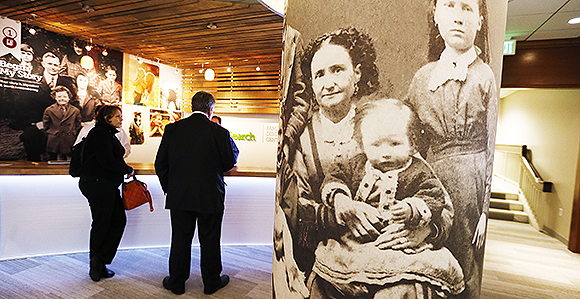FamilySearch in 2015: Becoming World’s Foremost Family History Resource

The Family Discovery Center in the Joseph Smith Memorial Building in Salt Lake City uses the latest technology to give patrons an "immersive experience" in their family's history.
FamilySearch International, the largest genealogy organization in the world, has been actively gathering, preserving, and sharing genealogical records worldwide for over 100 years.
Patrons may access FamilySearch services and resources free online at FamilySearch.org or through more than 4,891 family history centers in 129 countries, including the main Family History Library in Salt Lake City.
Following are several FamilySearch highlights for the year 2015.
HIGHLIGHTS FOR 2015
- Two family discovery centers, which represent a new concept in presenting family history information, were opened in Salt Lake City, Utah, and Bellevue, Washington. Ground was also broken for a new FamilySearch library in St. George, Utah, which will have some of the new discovery center experiences.
- RootsTech 2015, a global family history event held in Salt Lake City, Utah, and hosted by FamilySearch, used technology and fun experiences to expand family connections. It attracted a record 300,000 attendees in person, online, and through local post–Family Discovery Day events.
- FamilySearch, in cooperation with several other organizations, launched the Freedmen’s Bureau Campaign (discoverfreedmen.org) to finish digitizing and indexing Civil War–era records that are crucial to African American research success. This project should be completed in 2016.
- On October 23, FamilySearch celebrated the 30th anniversary of its well-known Family History Library in downtown Salt Lake City, which houses the largest and most expansive collection of family history records in the world.
DISCOVERY
- The My Family: Stories That Bring Us Together booklet, which provides an engaging way to capture and preserve family trees—particularly for those individuals and cultures who are less tech-savvy—was published in 42 languages.
- More and more people made use of the 4,891 local FamilySearch facilities. North America alone saw a 25 percent increase in attendance at these local libraries during 2015. Online, FamilySearch.org saw 291,806 visitors daily—an increase of 19 percent.
- New patron discovery experiences were launched in family history centers worldwide, and 1,505 local post–RootsTech family discovery day events were held.
- Enhancements were introduced to the FamilySearch.org Family Tree to assist patrons in creating more accurate records and to find records of their ancestors more easily. The site has introduced a redesigned landscape pedigree view, easier access to indicators in other tree views, and safeguard reminders to help patrons avoid making common editing mistakes.
- Dynamic record hints were added through the Search feature at FamilySearch.org to aid patrons in making new research discoveries. More than 670 million new patron hints were generated during the past year.
- Through partnerships with other major online genealogy sites, patrons can now use a single click to search ancestry.com, findmypast.com, and myheritage.com for the person they are viewing in FamilySearch’s Family Tree.
- This year’s FamilySearch innovations have made searching and recording personal and family experiences more user-friendly and have improved the accuracy of FamilySearch’s databases.
FAMILY TREE
- More than 120,000 new contributors added to Family Tree in 2015, making a total of 2.47 million. The new user-to-user messaging feature in Family Tree simplifies collaboration with others doing research on the same specific ancestors. There are now 1.1 billion persons in the FamilySearch Family Tree.
RECORDS
- The site launched 158 new historical collections in 2015 (bringing the total to 2,049), and hundreds of millions of new published records have been added to FamilySearch.org.
- Around the world, 319 camera teams—an increase of 11 percent—digitally preserved over 122 million records in 45 countries, and 304,000 online volunteer indexers helped make them searchable.
- Volunteers logged over 9 million hours and indexed over 110 million records in 2015. And 19 million of the records indexed were of international origin, in languages other than English.
- At the end of 2015, FamilySearch.org had more than 5.31 billion searchable names in historical records.
MEMORIES
- The FamilySearch Tree mobile app now enables users to attach photos and stories (audio and text) to individuals in their Family Tree and to receive notifications when others add content to specific individuals.
- The new memories gallery view allows users to more easily organize, sort, and add photos, stories, and scanned documents to their memories collections.
- Last year patrons uploaded 4 million personal family photos and 40,000 new family stories.
HELP
- In addition to online volunteers, 3,850 volunteers serve as FamilySearch missionaries, helping support the worldwide operations needs. These volunteers donated 3.04 million hours of service. FamilySearch joined with the Smithsonian National Museum of African American History and Culture and other organizations to index and publish online the Freedmen’s Bureau records, a Civil War–era collection that will prove pivotal for African American research success. A record 12,000 volunteers enlisted online to assist (see DiscoverFreedmen.org).
- FamilySearch also added 77 new family history centers around the world to provide free personal research assistance to patrons.

Patrons may access FamilySearch services and resources free online at FamilySearch.org or through more than 4,891 family history centers in 129 countries, including the main Family History Library in Salt Lake City. Graphic shows highlights from 2015.
